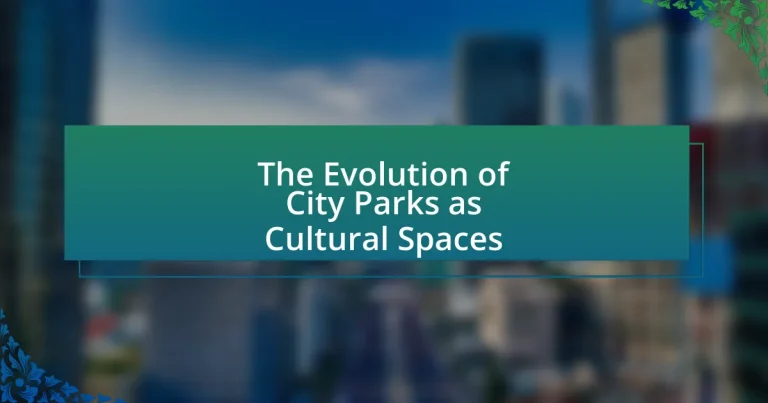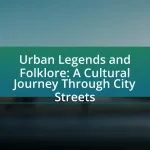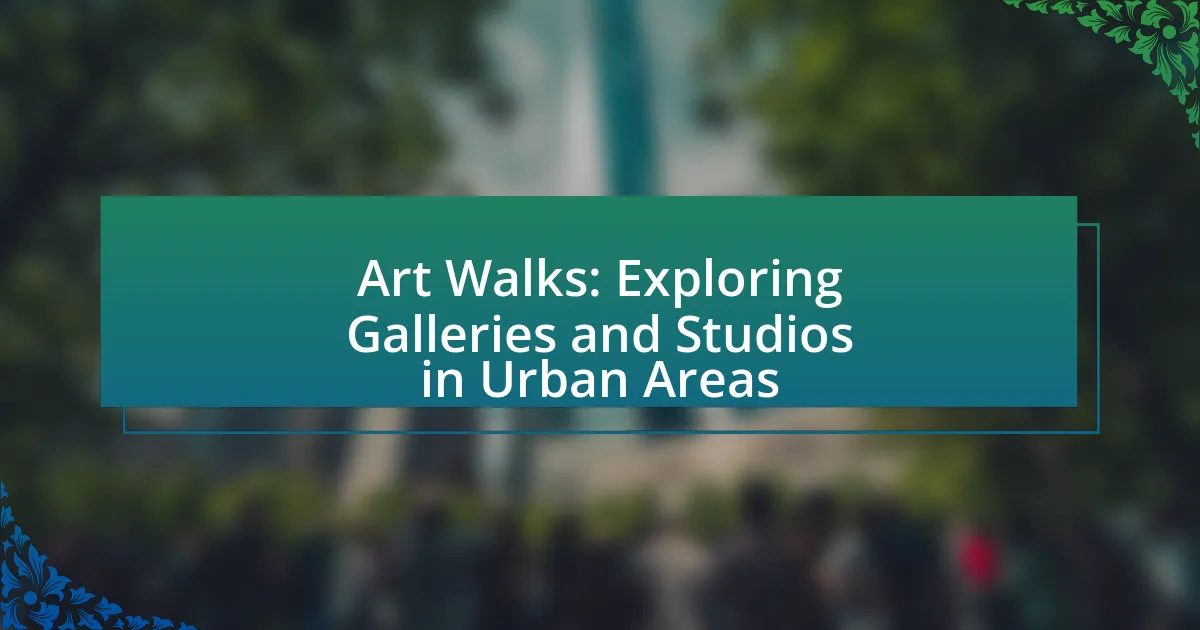City parks have evolved from simple recreational spaces to vital cultural hubs that foster community engagement, artistic expression, and social interaction. This article explores the significance of city parks as cultural spaces, examining their historical development, the impact of urbanization, and their roles in enhancing community identity and well-being. It highlights the challenges parks face in maintaining cultural relevance and discusses innovative strategies for improvement, including community involvement, diverse programming, and sustainability practices. Additionally, the article addresses future trends in city parks, emphasizing the integration of technology and the importance of preserving these spaces as reflections of local culture and heritage.
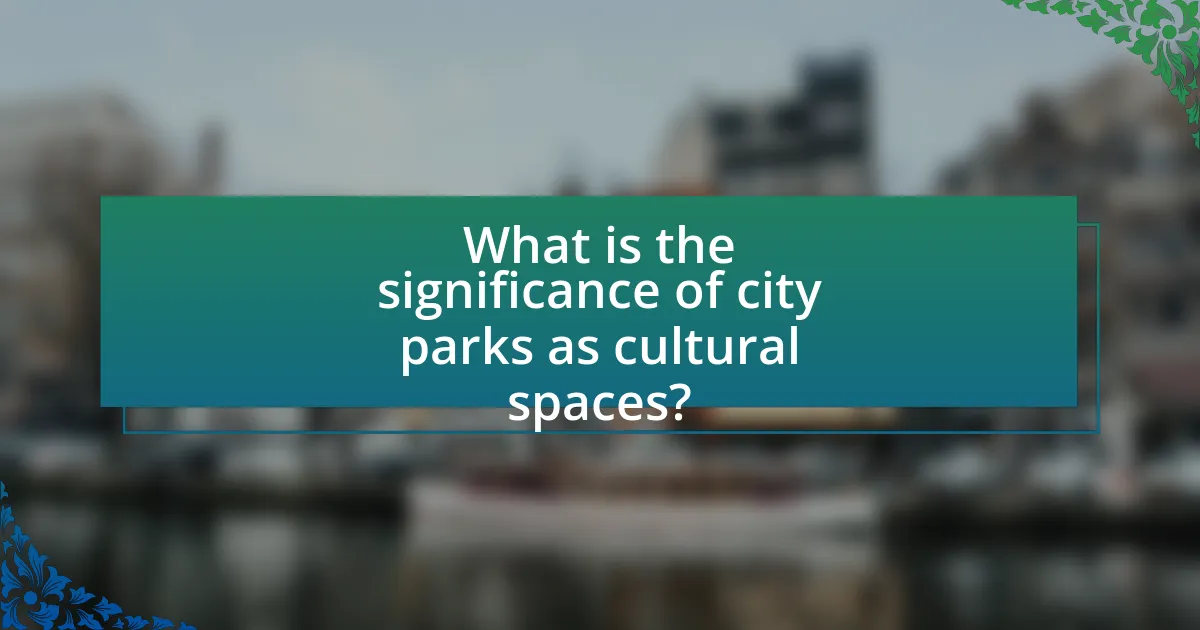
What is the significance of city parks as cultural spaces?
City parks serve as significant cultural spaces by providing venues for community engagement, artistic expression, and social interaction. These parks often host cultural events, festivals, and performances that reflect the local heritage and diversity, fostering a sense of belonging among residents. For instance, studies have shown that urban parks contribute to cultural identity by showcasing public art installations and hosting cultural celebrations, which enhance community cohesion. Additionally, the presence of green spaces has been linked to improved mental well-being, further emphasizing their role as vital cultural hubs in urban environments.
How have city parks evolved over time?
City parks have evolved from utilitarian green spaces primarily for recreation and public health in the 19th century to multifunctional cultural hubs that promote biodiversity, community engagement, and social equity in the 21st century. Initially designed for leisure and health benefits, such as the establishment of Central Park in 1858 to provide urban dwellers with access to nature, city parks have increasingly incorporated diverse features like playgrounds, sports facilities, and cultural programming. Recent trends emphasize sustainability and inclusivity, with parks now serving as venues for community events, art installations, and environmental education, reflecting a shift towards recognizing their role in enhancing urban life and fostering social connections.
What historical factors influenced the development of city parks?
The development of city parks was influenced by several historical factors, including urbanization, public health movements, and landscape design philosophies. Urbanization in the 19th century led to overcrowded cities, prompting the need for green spaces to improve living conditions. Public health movements advocated for parks as essential areas for recreation and fresh air, which were believed to combat urban pollution and disease. Additionally, the landscape design philosophies of figures like Frederick Law Olmsted emphasized the aesthetic and social value of parks, shaping their design and function in urban environments. These factors collectively contributed to the establishment and evolution of city parks as vital cultural spaces.
How did urbanization impact the design of city parks?
Urbanization significantly influenced the design of city parks by prioritizing accessibility, multifunctionality, and ecological sustainability. As cities expanded, the need for green spaces that could accommodate larger populations and diverse activities became essential. This led to the integration of features such as walking paths, recreational facilities, and community gathering areas within parks, making them vital urban hubs. Historical examples include the transformation of Central Park in New York City during the mid-19th century, which was designed to provide a natural retreat amidst urban development, reflecting the growing recognition of parks as essential for public health and social interaction.
What roles do city parks play in urban communities?
City parks serve multiple essential roles in urban communities, including providing recreational spaces, enhancing biodiversity, and fostering social interactions. These parks offer residents areas for physical activities such as walking, jogging, and sports, which contribute to improved public health. Additionally, city parks support local ecosystems by providing habitats for various species, thus promoting biodiversity within urban settings. Socially, parks act as communal gathering spots where individuals from diverse backgrounds can interact, participate in events, and build community ties, which is crucial for social cohesion. Studies have shown that access to green spaces is linked to increased community engagement and overall well-being, highlighting the integral role city parks play in enhancing the quality of urban life.
How do city parks contribute to social interaction among residents?
City parks contribute to social interaction among residents by providing communal spaces where individuals can gather, engage in recreational activities, and participate in community events. These parks serve as venues for socializing, fostering relationships, and building a sense of community. Research indicates that parks enhance social cohesion; for instance, a study published in the Journal of Urban Affairs found that access to green spaces is positively correlated with increased social interactions among neighbors. Additionally, parks often host organized events, such as festivals and sports leagues, which further encourage residents to connect and collaborate, reinforcing community ties.
What cultural events are commonly hosted in city parks?
City parks commonly host cultural events such as music festivals, art fairs, outdoor movie screenings, and community celebrations. These events serve to engage the public, promote local artists, and foster community spirit. For instance, music festivals often feature local bands and attract large crowds, enhancing the cultural vibrancy of the area. Art fairs provide a platform for local artists to showcase their work, while outdoor movie screenings create a communal atmosphere for families and friends. Community celebrations, such as holiday festivals or cultural heritage days, further emphasize the role of city parks as vital cultural spaces that reflect the diversity and creativity of the community.
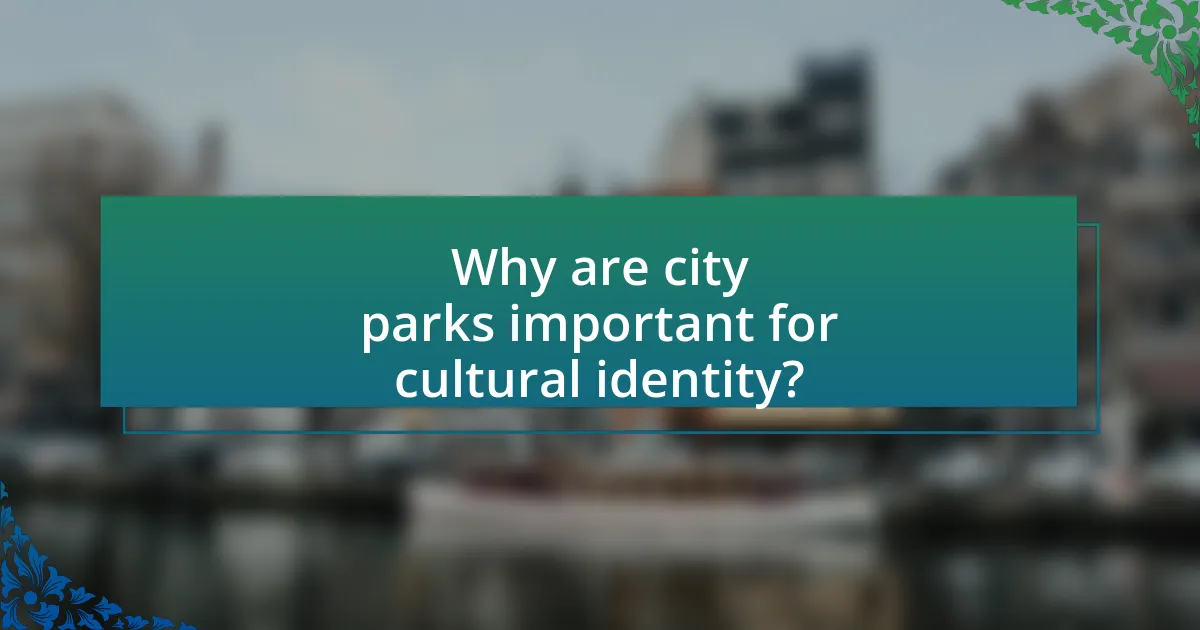
Why are city parks important for cultural identity?
City parks are important for cultural identity because they serve as communal spaces that reflect and promote the values, traditions, and social interactions of diverse communities. These parks often host cultural events, festivals, and gatherings that celebrate local heritage, thereby fostering a sense of belonging and community pride. For instance, studies have shown that parks like Central Park in New York City have historically been venues for cultural expression, hosting events that highlight the city’s multicultural fabric. This role in cultural representation and community engagement underscores the significance of city parks in shaping and maintaining cultural identity.
How do city parks reflect local culture and heritage?
City parks reflect local culture and heritage by serving as communal spaces that embody the historical, social, and artistic values of a community. For instance, parks often feature monuments, sculptures, and landscaping that celebrate local history or significant figures, such as the statue of a prominent leader in a city park, which can symbolize the community’s values and identity. Additionally, the design and use of parks can reflect cultural practices, such as traditional festivals or recreational activities unique to the area, showcasing the community’s lifestyle and heritage. Research indicates that parks designed with local flora and cultural elements foster a sense of belonging and pride among residents, reinforcing their connection to the area’s history and traditions.
What types of art and installations can be found in city parks?
City parks feature a variety of art and installations, including sculptures, murals, performance spaces, and interactive art. Sculptures often serve as focal points, with notable examples like the “Charging Bull” in Bowling Green Park, New York City, which attracts numerous visitors. Murals can transform park walls into vibrant canvases, enhancing the aesthetic appeal and community engagement. Performance spaces, such as amphitheaters, provide venues for concerts and theatrical performances, fostering cultural activities. Interactive art installations, like playgrounds designed by artists, encourage public participation and creativity. These diverse forms of art contribute to the cultural significance of city parks, making them vital community spaces.
How do city parks serve as venues for cultural expression?
City parks serve as venues for cultural expression by providing accessible spaces for community gatherings, artistic performances, and cultural festivals. These parks often host events such as concerts, art exhibitions, and cultural celebrations, which foster social interaction and community identity. For instance, the Central Park SummerStage in New York City features a variety of performances that highlight diverse cultural backgrounds, attracting thousands of attendees each year. Additionally, parks often display public art installations that reflect local heritage and artistic talent, further enhancing their role as cultural hubs.
What challenges do city parks face in maintaining their cultural relevance?
City parks face several challenges in maintaining their cultural relevance, primarily due to urbanization, changing demographics, and evolving community needs. Urbanization often leads to the reduction of green spaces, making it difficult for parks to serve as cultural hubs. Additionally, as populations become more diverse, parks must adapt to reflect the cultural identities and preferences of various communities. This includes programming that resonates with different cultural groups and addressing accessibility issues. Furthermore, funding constraints can limit the ability of parks to host events or maintain facilities that support cultural activities, thereby diminishing their role as vibrant community spaces.
How does funding affect the cultural programming in city parks?
Funding directly influences the cultural programming in city parks by determining the scope, quality, and variety of events and activities offered. Adequate funding allows for the hiring of skilled personnel, the organization of diverse cultural events, and the maintenance of facilities, which enhances community engagement and participation. For instance, a study by the National Recreation and Park Association found that cities with higher park funding reported a 30% increase in community events, showcasing the direct correlation between financial resources and cultural programming effectiveness.
What role does community involvement play in the preservation of cultural spaces in parks?
Community involvement is crucial for the preservation of cultural spaces in parks as it fosters a sense of ownership and responsibility among local residents. Engaged communities actively participate in the maintenance, programming, and advocacy for these spaces, ensuring they reflect the cultural heritage and needs of the population. For instance, studies have shown that parks with strong community engagement initiatives, such as volunteer clean-up days and cultural events, experience better upkeep and increased usage, which contributes to their longevity and relevance. Additionally, community input in decision-making processes helps to safeguard the cultural significance of these spaces, as seen in various urban park projects where local voices have shaped the design and function of cultural areas.
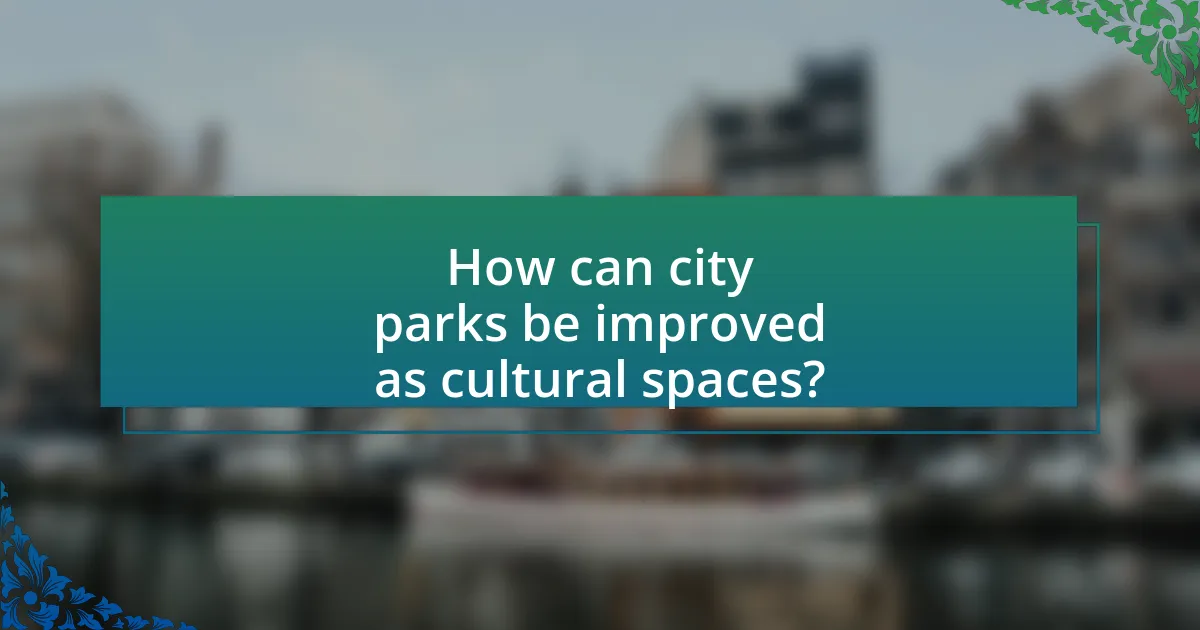
How can city parks be improved as cultural spaces?
City parks can be improved as cultural spaces by integrating diverse programming, enhancing accessibility, and incorporating art installations. Diverse programming, such as cultural festivals, art exhibitions, and community workshops, fosters engagement and attracts varied demographics, as evidenced by the success of events like the Central Park SummerStage in New York, which hosts over 100 performances annually. Enhancing accessibility through improved pathways, signage, and facilities ensures that all community members can participate, aligning with the Americans with Disabilities Act standards. Additionally, incorporating art installations, such as sculptures and murals, can transform parks into vibrant cultural hubs, as seen in the High Line in New York City, which features art from local and international artists, enriching the cultural experience for visitors.
What best practices can enhance the cultural offerings of city parks?
To enhance the cultural offerings of city parks, implementing community engagement initiatives is essential. Engaging local artists and cultural organizations to host events, workshops, and performances fosters a sense of ownership and relevance among residents. For instance, cities like San Francisco have successfully integrated art installations and cultural festivals into their parks, resulting in increased visitor participation and community pride. Additionally, providing diverse programming that reflects the demographics and interests of the community, such as multicultural festivals or educational programs, can attract a wider audience. Research indicates that parks with active cultural programming see a 30% increase in visitor numbers, demonstrating the effectiveness of these practices in enriching the cultural landscape of urban green spaces.
How can partnerships with local artists and organizations benefit city parks?
Partnerships with local artists and organizations can significantly enhance city parks by fostering community engagement and enriching cultural experiences. These collaborations often lead to the creation of public art installations, performances, and events that attract diverse audiences, thereby increasing park usage and community interaction. For instance, a study by the National Endowment for the Arts found that public art projects can boost local economies and enhance community identity. Additionally, local organizations can provide resources and expertise that improve park facilities and programming, making them more accessible and appealing to residents.
What innovative programs can be implemented to engage diverse communities in city parks?
Innovative programs that can be implemented to engage diverse communities in city parks include cultural festivals, community gardening initiatives, and multilingual educational workshops. Cultural festivals celebrate the unique traditions of various communities, fostering inclusivity and participation; for example, events like the National Puerto Rican Day Parade in New York City highlight cultural heritage and attract diverse attendees. Community gardening initiatives encourage collaboration among residents from different backgrounds, promoting social interaction and environmental stewardship, as evidenced by the success of community gardens in urban areas like Los Angeles, which have increased local food access and community cohesion. Multilingual educational workshops, such as those focused on health, wellness, or environmental conservation, can cater to non-English speakers, ensuring that all community members have access to valuable information and resources. These programs not only enhance community engagement but also transform city parks into vibrant cultural spaces that reflect the diversity of the population.
What are the future trends for city parks as cultural spaces?
Future trends for city parks as cultural spaces include increased community engagement, multifunctional design, and integration of technology. City parks are evolving to serve as venues for cultural events, art installations, and social gatherings, fostering a sense of community. Research indicates that parks designed for multiple uses, such as performance spaces and art showcases, enhance cultural participation and accessibility. Additionally, the incorporation of smart technology, such as augmented reality experiences and interactive installations, is becoming prevalent, allowing visitors to engage with cultural narratives in innovative ways. These trends reflect a shift towards parks being not just recreational areas but vital cultural hubs that promote social interaction and community identity.
How might technology influence the cultural experiences in city parks?
Technology significantly influences cultural experiences in city parks by enhancing accessibility, engagement, and interaction. For instance, mobile applications provide information about park events, history, and flora, allowing visitors to engage more deeply with their surroundings. Additionally, augmented reality (AR) experiences can offer immersive storytelling, transforming a simple walk into an educational journey about local culture and history. Research indicates that parks equipped with Wi-Fi and digital kiosks see increased visitor engagement, as people utilize these resources for social media sharing and event participation. This integration of technology not only enriches the visitor experience but also fosters a sense of community and cultural exchange within urban environments.
What role will sustainability play in the evolution of city parks?
Sustainability will play a critical role in the evolution of city parks by guiding their design, maintenance, and functionality to meet environmental and community needs. As urban areas face challenges like climate change and biodiversity loss, city parks will increasingly incorporate sustainable practices such as native plant landscaping, water-efficient irrigation systems, and renewable energy sources. For instance, a study by the American Society of Landscape Architects highlights that parks designed with sustainability in mind can reduce urban heat islands and improve air quality, thereby enhancing the overall health of urban populations. This shift towards sustainability not only preserves natural resources but also fosters community engagement and promotes social equity by providing accessible green spaces that benefit all residents.
What practical steps can communities take to revitalize their city parks?
Communities can revitalize their city parks by implementing a combination of community engagement, infrastructure improvements, and programming initiatives. Engaging local residents through surveys and meetings allows communities to identify specific needs and desires for park features, ensuring that revitalization efforts reflect the community’s priorities. Infrastructure improvements, such as repairing pathways, adding lighting, and enhancing landscaping, can significantly increase park usability and safety. Additionally, programming initiatives, including organized events, fitness classes, and cultural activities, can attract diverse groups and foster a sense of ownership among residents. According to a study by the National Recreation and Park Association, parks with active programming see a 30% increase in visitor engagement, demonstrating the effectiveness of these revitalization strategies.
